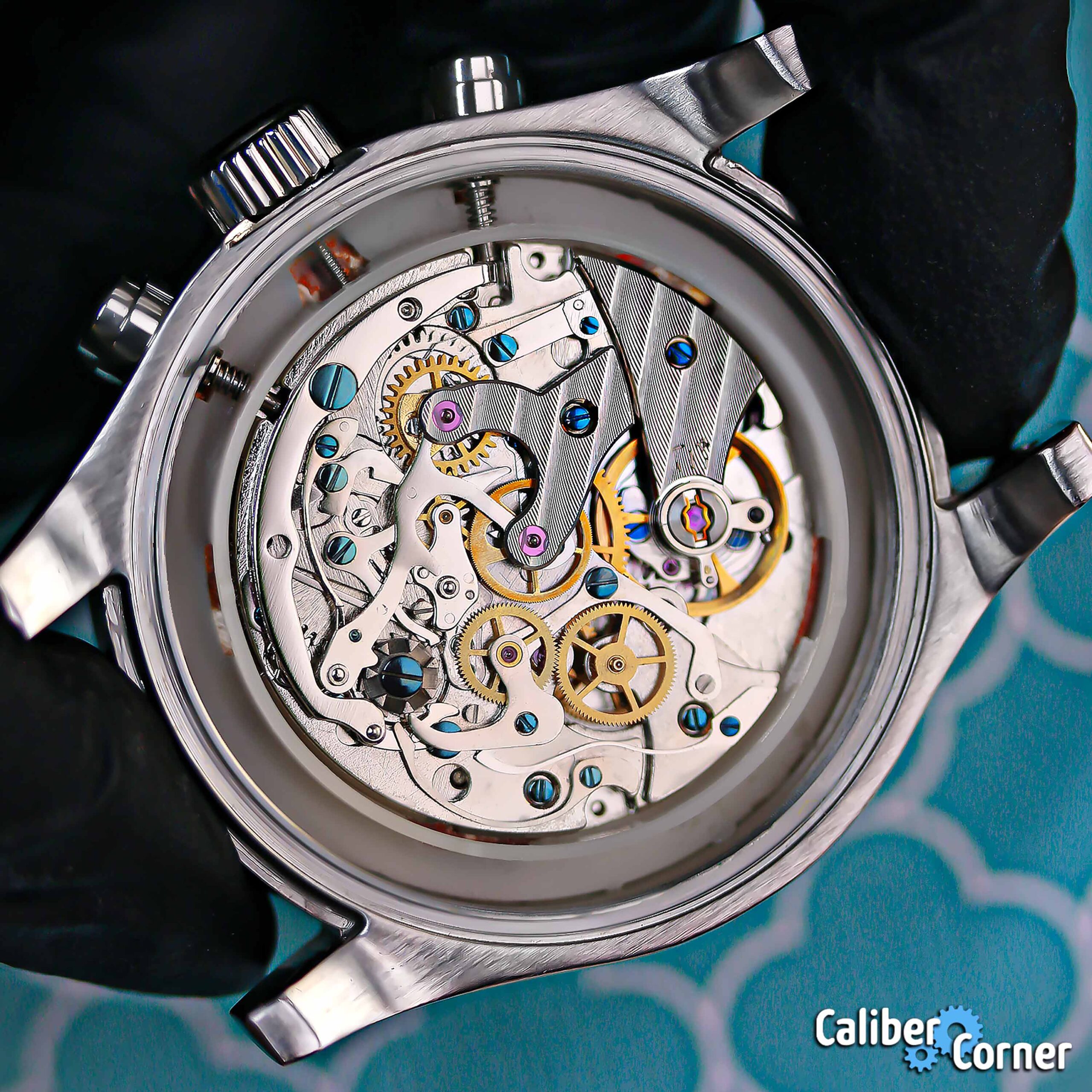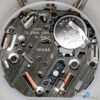| Manufacturer | Seiko |
| Caliber Number | 1B21 |
| Movement Type | Solar radio signal (solar radio wave control), quartz |
| Jewels | 4 (needs confirmed) |
| Frequency | 32,768Hz |
| Battery Cell | See below! |
| Battery Power Reserve | 6 months |
| Accuracy | +/- 15 seconds per month |
| Driving System | Step motor |
| Integrated Circuit | 2 pieces, for the oscillator, frequency divider, drive, and reception circuit |
| Hand Count | 3 hands |
| Functions | Central hours; central minutes; central seconds |
| Hacking Seconds? | Yes |
| Country of Manufacture | Japan |
| Known Models | (Add yours in the comments below…) |
The Seiko caliber 1B21 a solar radio signal movement found in ladies size Seiko watches. It is has a basic 3-hander no-date layout.
Some of the topics covered in this caliber listing:
Solar Charging and Power Reserve:
How long to fully charge?
To fully charge the 1B21, the watch dial needs to be exposed to the light for a certain amount of time depending on the type of light. The table below is from the Seiko official manual. You can see that sunlight will get you the shortest charging time of 24 hours until fully charged, whereas fluorescent lighting will take 200 hours of continuous light. This caliber cannot be overcharged since it has a built-in overcharge prevention function.
Note: when placing your watch on the windowsill to charge with sunlight, make sure it’s not too hot! It can damage the solar cell or even warp the dial (know this from experience).
How to know if it needs charged?
The 1B21 has a low energy warning indicator. When this feature kicks in, the seconds hand will skip, ticking every two seconds – this means you need to charge the watch. If the watch has been ticking in 2 second intervals and still hasn’t been charged, it will start ticking in 5 second intervals – this mean you really need to charge the watch. Eventually it will stop. When the low power indicator it on, the watch will not receive radio signal transmission.
How long will it work on a full charge?
On a full charge, the calibre 1B21 will run for up to 6 months.
Accuracy Rating:
According to official Seiko documentation, they claim that the average monthly rate the 1B21 is less than +/- 15 seconds under normal conditions. With regards to the 1B21, “normal” temperatures should be within the range of 5°C ~ 35°C (41°F ~ 95°F) for the best accuracy, however, the movement can still operate between -10C ~ 60C (14F ~ 140F).
Setting the Time:
As a radio-controlled watch movement, the time on the 1B21 is adjusted automatically via radio signals it receives each day between 2am-4am. If for some reason you miss the transmission, the radio signal can be triggered again manually.
How to set the time manually:
- Pull the crown out two clicks (don’t stop at the first click), then push it back in. The second hand should stop at 12:00.
- Press the button located at 4:00 on the side of the case. Pressing the hand for 2 seconds will advance the seconds hand, it will advance the time by one minute.
- When the desired time is reached, pull the crown out two clicks then push it back in.
Note: The hands cannot be set via the crown. Also, the time cannot be set backwards.
Radio Signal Reception:
According to Seiko documentation, the radio signal reception can be received in Japan, USA, China, and Germany. If have a 1B21 in a location other than those countries, please comment with your experience below. From the Seiko documentation:
“Radio signal reception function / radio signal transmitting station: Japan (2 stations), China, U.S.A. and Germany. Automatic reception (before 2:00 a.m. and 4:00 a.m.) *It varies depending on the radio signal receiving condition. *After radio signal reception, the watch will start to work depending on the quartz movement until the next reception. *Manual reception is available.”
Depending on the country, the range of reception is about 1,000km/621 miles from each station (for Japan and Germany), and about 1,500km/932 miles for USA and China.
The antenna in your watch is located at 8:00, therefore, you will get the best results when that side of the watch is facing in the transmitting station’s direction. It is best to not move the watch when it is receiving transmission.
What are the letters on the dial?
The dial of a 1B21 watch will have small letters at 2, 4, 8, and 10:00:
- Y (2:00) – Successful reception
- N (4:00) – Failed reception, not receiving radio signals
- L (8:00) – Low reception quality
- H (10:00) – High reception quality
A second set of letters indicates the transmitting station:
- D (1 second position) – Germany (DCF77) / PTB
- J (9 seconds position) – Japan (JJY) / NICT
- B (8 seconds position) – China (BCP) / NTSC
- W (53 seconds position) – USA (WWVB) / NIST
Manual Radio Signal Reception:
- Make sure you are in a location that is within range of the transmission station.
- Make sure the 8:00 side of the watch is facing that station.
- Press the button (located at 4:00 on the side of the case) for 3 seconds and release when the seconds hand move to the 12:00 position. This indicates that a reception attempt is being made.
- It can take up to 12 minutes to receive the radio signal. The quality of reception will be indicated with the second hand pointing to the corresponding letter on the dial (see above).
- When the transmission is complete, the seconds hand will begin ticking in one second intervals again. If the transmission failed, the second hand will point to N on the dial.
Capacitor/Battery Replacement:
Seiko does not provide replacement battery information for this caliber. It appears that they do not provide the part or have a part number either, it is listed as: “No supply of a rechargeable battery unit.” Interestingly, their service docs also include the following notation:
“Radiowave controlled watches are serviced only by the service center which is equipped with a shield room and time signal generators.”
This means that caliber 1B21 watches cannot be serviced in USA or anywhere else except for Japan. If you have successfully changed your own capacitor/battery, or if you have sent your 1BXX powered watch to Seiko for service, please comment below.
Do not attempt to retrofit a regular battery into this caliber.
Caliber 1B21 VS 1B22:
There is a similar caliber 1B22 with the main difference being that the 1B21 is a 3-hander no-date and the 1B22 has a date at 3:00.
Pros and Cons:
Pros:
- It’s fun to have a radio controlled watch in the collection
- If you can keep it charged, you don’t need to worry about battery replacement for a while.
- Automatically sets the time for you if you are within range of a transmission station
Cons:
- It’s a hassle to set the time manually!
- It takes a long time to charge.
- It needs to go back to Japan for proper service of a new capacitor/battery, no parts available.





 network of watch sites
network of watch sites





















Trending Comments
Longines Caliber L836.6
The differenece is the beat rate. 3Hz vs 5Hz. 6 beats/s vs 10 beats/s.
Orient Caliber F6922
I've had my Mako and Ray Orient watches with these calibers, I guess. Their performance…
Invicta Caliber JSD-006ZY
Apart from the fact, that there is no further information about this caliber anywhere, it…
Seiko Instruments (SII) Caliber VH31
the VH-31 movement coupled with solar or kinetic in a Seiko watch would sell like…
Miyota/Citizen Caliber 9051
I have the 9051 in my Fujitsubo, it appears to be within 3 seconds. I'll…
Active Caliber Listings
It might be a Chinese Standart-movement aka Tong Ji aka 7120 / SS7 with an…
Thank you for sharing your experience with the community. If possible, please submit images of…
Apart from the fact, that there is no further information about this caliber anywhere, it…
This £80 lorus has the y676c with Japan on the rotor
Minute hand on some ETA's 2-hand quartz movements run every 20 secs so that the…